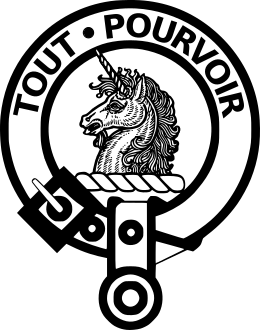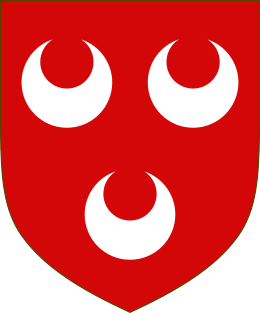Clan Oliphant facts for kids
Quick facts for kids Clan Oliphant |
|||
|---|---|---|---|
 |
|||
| Motto | Tout pourvoir (From French: Provide for all) | ||
| Chief | |||
 |
|||
| Richard Eric Laurence Oliphant of that Ilk | |||
| Chief of the Name and Arms of Oliphant | |||
| Seat | None | ||
| Historic seat | Aberdalgie, Dupplin Castle and Kellie Castle | ||
|
|||
|
|||
|
|||
Clan Oliphant is a historic Highland Scottish clan. This means it is a group of families who share a common ancestor and a strong sense of community. The clan has a long and interesting history in Scotland, playing a part in many important events.
Contents
History of Clan Oliphant
Early Beginnings
The first known member of the Oliphant family was Roger Olifard. He was mentioned in old documents from England between 1093 and 1100. Some people believe the Oliphants originally came from France. By the 1100s, they owned land in England, especially around Northamptonshire.
A very important early Oliphant was David Olifard. He was the godson of King David I of Scotland. In 1141, David Olifard bravely saved his godfather, King David I, from being captured during a battle. He was given lands in Scotland, including Crailing and Smailholm. David Olifard also served as a Justiciar of Lothian, which was a high legal position. His son, Sir Walter Olifard, later married Christian, the daughter of an important Scottish Earl.
Fighting for Scottish Freedom
The Oliphant name appeared on the Ragman Rolls in 1296. This was a list of Scottish nobles who had to promise loyalty to King Edward I of England. But like many Scots, the Oliphants soon joined the fight for Scotland's independence.
During the Wars of Scottish Independence, a brave knight named Sir William Oliphant fought against the English. He was captured twice and imprisoned in England. In 1304, he was the leader of Stirling Castle, which was the last Scottish stronghold against King Edward I. He defended the castle for three months before it surrendered. Sir William was sent to the Tower of London.
His cousin, William Oliphant, Lord of Aberdalgie, also fought for Scotland. He was captured and sent to prison too. Later, he served King Robert the Bruce in the fight against the English. He was one of the people who signed the Declaration of Arbroath in 1320. This famous letter asked the Pope to recognize Scotland's independence. For his loyalty, he received new lands in Scotland.
Sir Walter Oliphant, son of Sir William, married Princess Elizabeth. She was the youngest daughter of King Robert the Bruce. This marriage showed the strong connection between the Oliphant family and the Scottish royal family.
Clan Conflicts and Royal Connections
In the 15th century, the Oliphants continued to be involved in important events. Sir John Oliphant, Lord of Aberdalgie, was killed in 1445. He was supporting Clan Ogilvy in a clan battle against Clan Lindsay.
Sir Laurence Oliphant of Aberdalgie became a Lord of Parliament in 1458. This meant he was a very important noble in the Scottish government. He was also the keeper of Edinburgh Castle.
Battles and Challenges
During the Anglo-Scottish Wars, the Oliphants continued to fight for Scotland. In 1513, a grandson of Sir Laurence Oliphant was killed at the Battle of Flodden. Later, in 1542, his great-grandson was captured at the Battle of Solway Moss.
The fourth Lord Oliphant supported Mary, Queen of Scots. He fought for her at the Battle of Langside in 1568. The chief's eldest son, Laurence, was involved in a plan to kidnap the young King James VI of Scotland. Because of this, he had to leave Scotland in 1582. Sadly, his ship was lost at sea.
Changing Times and Jacobite Risings
In the 17th century, there was a legal case about who should be the next Lord Oliphant. King Charles I of England created a new title for one branch of the family. He also created a new Lord Oliphant title for the nearest male cousin.
Many Oliphants were strong supporters of the Jacobite cause. This was a movement that wanted to bring the old royal family back to the throne. Charles Oliphant, the ninth Lord Oliphant, fought at the Battle of Killiecrankie in 1689. He was later imprisoned for his role.
In the 18th century, the Oliphants continued their support for the Jacobites. Charles Oliphant strongly opposed the Treaty of Union in 1707. This treaty joined Scotland and England into Great Britain. He joined the Jacobite rising of 1715. The last Lord Oliphant also played a big part in the Jacobite rising of 1745. After the defeat at the Battle of Culloden, he had to escape to Sweden and France. He was allowed to return to Scotland in 1763.
Carolina Oliphant (Lady Nairne) was a famous Jacobite poet. She was the daughter of the Oliphant Laird of Gask.
Clan Oliphant Today
Clan Chief
Today, the Clan Chief is Richard Eric Laurence Oliphant of that Ilk. He was officially recognized as the Chief of the Name and Arms of Oliphant in 2003. This means he is the official head of the clan.
Clan Chieftains
The Clan Oliphant has several important branches, each with its own chieftain. These chieftains help lead different parts of the clan.
- Oliphant of Condie: This branch has produced many notable people. These include an Ambassador, a Chairman of the East India Company, and a Chief Justice of Ceylon. One member, Sir Anthony Oliphant, helped start Sri Lanka's tea industry. Another, Thomas Oliphant (musician and artist), was a musician who wrote words for the Christmas carol "Deck the Hall(s) with Boughs of Holly."
- Oliphant of Rossie: This branch includes Robert Oliphant, who was a Postmaster General for Scotland. More recently, Betty Oliphant co-founded Canada's National Ballet School.
- Oliphant of Gask: Laurence Kington Blair Oliphant of Ardblair and Gask is the chieftain of this branch. This family produced the famous poetess, Carolina Oliphant, Lady Nairne. The Gask Oliphants now live at Ardblair Castle. This castle holds many important Oliphant family treasures and old documents.
- Oliphant of Kellie: This branch owned Kellie Castle for 250 years. It also produced the well-known author, Margaret Oliphant.
Other Branches
Other branches of Clan Oliphant exist around the world. These include a US General, the famous Australian scientist Sir Mark Oliphant (who worked on the Manhattan Project), and the influential cartoonist Pat Oliphant.
Clan Tartan
| Tartan image | Notes |
|---|---|
 |
The Olyfavnt tartan, first shown in 1842. |
Clan Castles and Homes
- Kellie Castle was owned by the Oliphants from 1360 to 1613.
- Hatton Castle was built in 1575 by Laurence, the 4th Lord Oliphant. It replaced an older wooden fort nearby. Hatton Castle has been restored in recent times.
- The Oliphants also held lands at Gask in Perthshire. While there was no castle there, it was the location of "The Auld Hoose" mentioned in Carolina Oliphant's famous song.
- Today, there is no single main Clan Seat. However, Ardblair Castle, near Blairgowrie, is the home of the Oliphant of Gask chieftain. It holds the largest collection of Oliphant family items and portraits.
See also

